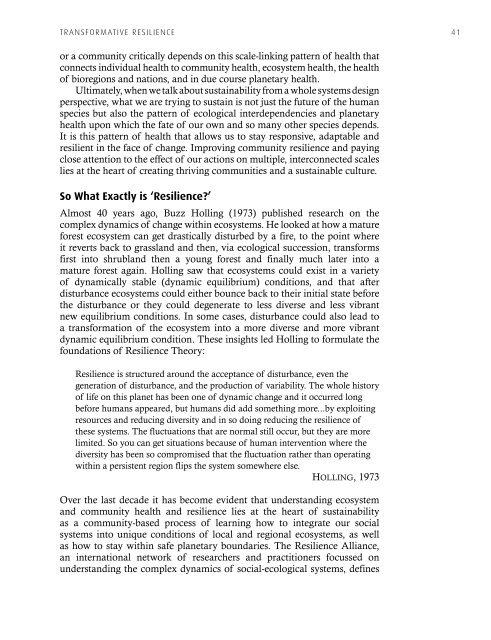Designing Ecological Habitats - Gaia Education
Designing Ecological Habitats - Gaia Education
Designing Ecological Habitats - Gaia Education
You also want an ePaper? Increase the reach of your titles
YUMPU automatically turns print PDFs into web optimized ePapers that Google loves.
transformative resilience 41<br />
or a community critically depends on this scale-linking pattern of health that<br />
connects individual health to community health, ecosystem health, the health<br />
of bioregions and nations, and in due course planetary health.<br />
Ultimately, when we talk about sustainability from a whole systems design<br />
perspective, what we are trying to sustain is not just the future of the human<br />
species but also the pattern of ecological interdependencies and planetary<br />
health upon which the fate of our own and so many other species depends.<br />
It is this pattern of health that allows us to stay responsive, adaptable and<br />
resilient in the face of change. Improving community resilience and paying<br />
close attention to the effect of our actions on multiple, interconnected scales<br />
lies at the heart of creating thriving communities and a sustainable culture.<br />
So What Exactly is ‘Resilience?’<br />
Almost 40 years ago, Buzz Holling (1973) published research on the<br />
complex dynamics of change within ecosystems. He looked at how a mature<br />
forest ecosystem can get drastically disturbed by a fire, to the point where<br />
it reverts back to grassland and then, via ecological succession, transforms<br />
first into shrubland then a young forest and finally much later into a<br />
mature forest again. Holling saw that ecosystems could exist in a variety<br />
of dynamically stable (dynamic equilibrium) conditions, and that after<br />
disturbance ecosystems could either bounce back to their initial state before<br />
the disturbance or they could degenerate to less diverse and less vibrant<br />
new equilibrium conditions. In some cases, disturbance could also lead to<br />
a transformation of the ecosystem into a more diverse and more vibrant<br />
dynamic equilibrium condition. These insights led Holling to formulate the<br />
foundations of Resilience Theory:<br />
Resilience is structured around the acceptance of disturbance, even the<br />
generation of disturbance, and the production of variability. The whole history<br />
of life on this planet has been one of dynamic change and it occurred long<br />
before humans appeared, but humans did add something more...by exploiting<br />
resources and reducing diversity and in so doing reducing the resilience of<br />
these systems. The fluctuations that are normal still occur, but they are more<br />
limited. So you can get situations because of human intervention where the<br />
diversity has been so compromised that the fluctuation rather than operating<br />
within a persistent region flips the system somewhere else.<br />
holling, 1973<br />
Over the last decade it has become evident that understanding ecosystem<br />
and community health and resilience lies at the heart of sustainability<br />
as a community-based process of learning how to integrate our social<br />
systems into unique conditions of local and regional ecosystems, as well<br />
as how to stay within safe planetary boundaries. The Resilience Alliance,<br />
an international network of researchers and practitioners focussed on<br />
understanding the complex dynamics of social-ecological systems, defines







